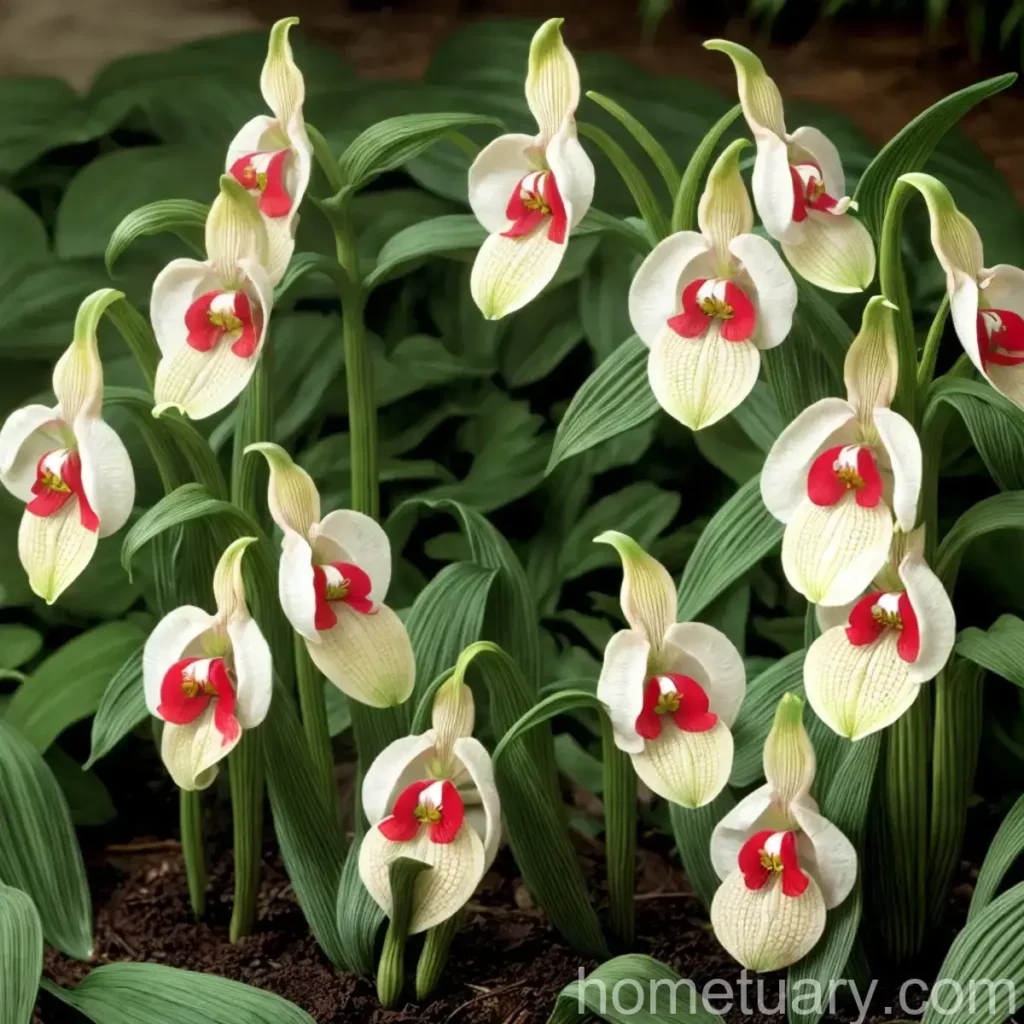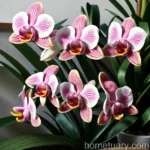The Fascinating World of the Lady’s Slipper Orchid (Cypripedium kentuckiense)
Introduction
In the enchanting realm of Kentucky’s native flora, the Cypripedium kentuckiense, more commonly known as the lady’s slipper orchid, stands out as an elegant and captivating species. Its delicate yet resilient nature has made it a subject of fascination for botanists, conservationists, and plant enthusiasts alike. In this comprehensive guide, we will delve into the intricate details of this remarkable orchid species, exploring its culture, uses, habitat, and conservation efforts.
What is the Lady’s Slipper (Cypripedium kentuckiense)?
The Cypripedium kentuckiense is a magnificent flowering plant belonging to the orchid family, known for its distinctive slipper-shaped pouch that gives it its common name. It is a native orchid species found in the rich woodlands and lush meadows of Kentucky. The striking blooms of the lady’s slipper orchid, with their vibrant colors and unique structure, make it a sought-after sight for nature enthusiasts and horticulturists.
Key Takeaways on the Lady’s Slipper (Cypripedium kentuckiense)
- The lady’s slipper (Cypripedium kentuckiense) is a native orchid species found in Kentucky.
- It is known for its characteristic slipper-shaped pouch, which gives it its common name.
- The plant is an integral part of the Appalachian flora and adds to the rich biodiversity of Kentucky’s natural landscape.
- The species is a subject of conservation efforts due to its rarity and the threats to its natural habitats.
Culture
The culture of the lady’s slipper orchid encompasses various aspects, including its preferred water and sunlight conditions, fertilizer needs, and appropriate soil for optimal growth.
Water
The lady’s slipper orchid thrives in moist but well-draining soil. As with most orchids, it is essential to avoid waterlogging, which can lead to root rot. A consistent watering schedule is crucial, ensuring that the plant’s roots remain hydrated without becoming waterlogged. As a general guideline, watering the lady’s slipper orchid every 7-10 days, depending on environmental conditions, can provide the ideal moisture balance for the plant.
Sunlight
In its natural habitat, the lady’s slipper orchid often grows in the dappled shade of woodlands, receiving gentle sunlight filtered through the tree canopy. When cultivating this orchid, it is essential to replicate these lighting conditions as closely as possible. Indirect or filtered sunlight is ideal for the lady’s slipper, as direct sunlight can scorch its delicate foliage. Placing the plant near an east or north-facing window or using sheer curtains to diffuse strong sunlight can help achieve the right lighting balance.
Fertilizer
Proper fertilization plays a crucial role in the healthy growth of the lady’s slipper orchid. A balanced, diluted fertilizer formulated specifically for orchids can provide the necessary nutrients for robust flowering and overall plant vitality. During the active growing season, which typically spans from early spring to late summer, a half-strength orchid fertilizer can be applied every 2-4 weeks. As the plant enters its dormant phase in the fall and winter, it is best to reduce or eliminate fertilization until new growth resumes in the following spring.
Soil
The lady’s slipper orchid thrives in a well-aerated, organic growing medium that mimics the loose, humus-rich soils of its native woodland habitats. A blend of fine fir bark, sphagnum moss, and perlite can create an ideal potting mix for this orchid, providing the necessary drainage and moisture retention while allowing air to reach the roots. When potting or repotting the lady’s slipper orchid, it is important to use a container with drainage holes to prevent water from accumulating at the root system’s base.
Pruning
Pruning is a minimal aspect of lady’s slipper orchid care, as the plant’s natural growth pattern and flowering habits generally require minimal intervention. Removing spent blooms and damaged foliage is the primary focus of pruning. This not only keeps the plant tidy but also encourages the diversion of energy into new growth and future flowering cycles. Sharp, sterile scissors or pruning shears can be used to trim away any dead or unsightly parts of the plant, ensuring that the lady’s slipper orchid maintains its graceful appearance.
Propagation
Propagating the lady’s slipper orchid can be a rewarding yet challenging endeavor, as the species has specific requirements for successful reproduction. The propagation methods for this orchid primarily involve division and seed germination.
Division
Dividing mature lady’s slipper orchid plants is a common propagation technique. This method involves carefully separating the plant’s rhizomes or tubers into individual sections, each with viable growing points or buds. Divisions should be performed during the plant’s dormant period, typically in late summer or early fall. The newly divided segments can then be potted in a suitable growing medium and provided with the appropriate care to encourage successful establishment and growth.
Seed Germination
Seed propagation of the lady’s slipper orchid requires patience and attention to detail, as the seeds have specific germination requirements. The species’ reliance on a symbiotic relationship with mycorrhizal fungi for seed germination adds to the complexity of this propagation method. The seeds must be sown in a sterile, well-draining substrate and kept moist under controlled conditions. Encouraging the development of mycorrhizal associations, which are essential for the seeds’ germination and subsequent growth, is a critical aspect of successfully propagating the lady’s slipper orchid from seeds.
Container Popularity
The appeal of cultivating lady’s slipper orchids in containers lies in the ability to create optimal growing conditions while showcasing the plant’s intricate beauty in a controlled environment. Container-grown lady’s slipper orchids can thrive in various settings, from indoor displays to outdoor gardens and shaded patios.
Indoor Display
Bringing the allure of lady’s slipper orchids into indoor spaces allows plant enthusiasts to appreciate their captivating blooms and delicate foliage up close. In well-lit areas with indirect sunlight, such as near windows or under skylights, potted lady’s slipper orchids can thrive as elegant ornamental pieces, adding a touch of natural beauty to the interior environment. Choosing decorative containers that complement the plant’s aesthetic and maintaining the appropriate care routine can enhance the visual impact of indoor lady’s slipper orchid displays.
Outdoor Gardens
Integrating lady’s slipper orchids into outdoor garden settings, such as shaded borders, woodland gardens, or patio displays, offers an opportunity to create enchanting natural vignettes. Incorporating these orchids into container gardens alongside ferns, mosses, and other shade-loving plants can enhance the overall texture and visual appeal of the outdoor space. The controlled environment of containers also enables gardeners to provide the specific growing conditions that lady’s slipper orchids require, ensuring their optimal health and vigor within the garden setting.
Common Diseases
While the lady’s slipper orchid is generally resilient, it is susceptible to certain diseases and ailments, particularly when grown in suboptimal conditions. Understanding these potential issues and their management is crucial for maintaining the health and vitality of the plant.
Disease Diagnosis
Several common diseases, such as fungal infections and viral ailments, can affect the lady’s slipper orchid. Symptoms of disease include yellowing or browning of foliage, distorted growth, and a general decline in the plant’s overall vigor and appearance. Conducting a thorough inspection of the plant, including its leaves, stems, and roots, can provide valuable insights into the nature of the disease. Diagnosis may also involve assessing environmental factors, such as humidity levels and air circulation, to identify potential contributors to disease development.
Common Pests
Pests pose a potential threat to the lady’s slipper orchid, with insect infestations being a primary concern. Common pests that can affect these orchids include aphids, spider mites, and scale insects. Monitoring the plant regularly for signs of pest activity, such as stippling or discoloration of leaves, honeydew secretion, or the presence of tiny insects, can aid in early pest detection. Implementing appropriate pest management strategies, such as mechanical removal, insecticidal soaps, or horticultural oils, can help mitigate pest infestations and protect the plant from significant damage.
Botanist’s Tips
As botanical enthusiasts with a passion for the lady’s slipper orchid, it is essential to impart valuable tips for cultivating and appreciating this remarkable species. The following tips can serve as guidance for successfully growing and enjoying lady’s slipper orchids.
Tip 1: Emulate Natural Habitat Conditions
Creating growing conditions that mimic the lady’s slipper orchid’s native woodland habitats is essential for its overall health and well-being. Providing suitable lighting, moisture levels, and organic growing media that align with the plant’s natural environment can foster robust growth and abundant flowering.
Tip 2: Monitor Environmental Factors
Regularly monitoring environmental variables, such as temperature, humidity, and airflow, can help maintain optimal growing conditions for the lady’s slipper orchid. By adjusting these factors as needed, plant enthusiasts can create a balanced microclimate that promotes the plant’s health and vitality.
Tip 3: Support Conservation Efforts
Given the lady’s slipper orchid’s status as a rare and endangered species in some regions, supporting conservation initiatives and ethical sourcing practices is crucial. Engaging in responsible cultivation and propagation methods, as well as advocating for habitat preservation, contributes to the broader conservation efforts aimed at safeguarding this and other endangered plant species.
Fun Facts
- The lady’s slipper orchid is a source of intrigue and admiration due to its unique slipper-shaped pouch that serves as a landing platform for pollinators.
- The species is an integral part of Kentucky’s natural heritage, contributing to the state’s diverse floral landscape and cultural significance.
- Lady’s slipper orchids have been traditionally associated with symbolism representing grace, beauty, and resilience, which adds to their allure and mystique.
Links to External Resources
To further explore the world of lady’s slipper orchids, here are some recommended external resources:
-
Kentucky Native Plant Society: The Kentucky Native Plant Society offers valuable information and resources related to native flora, including the lady’s slipper orchid.
-
United States Botanic Garden: The United States Botanic Garden provides educational content and plant conservation resources, offering insights into the cultivation and preservation of native orchid species.
-
International Union for Conservation of Nature (IUCN): The IUCN’s Red List of Threatened Species provides detailed assessments and conservation status updates for the lady’s slipper orchid and other rare plant species.
-
American Orchid Society: The American Orchid Society serves as a hub of orchid-related knowledge, offering expertise on the cultivation, care, and conservation of various orchid species, including the lady’s slipper orchid.
-
Kentucky Department of Fish and Wildlife Resources: The Kentucky Department of Fish and Wildlife Resources offers resources and conservation updates related to Kentucky’s native flora and fauna, including the lady’s slipper orchid.
In conclusion, the lady’s slipper orchid (Cypripedium kentuckiense) is a captivating and cherished component of Kentucky’s natural heritage, symbolizing the state’s rich biodiversity and cultural significance. By delving into the intricacies of its culture, propagation, and conservation, plant enthusiasts can gain a deeper appreciation for this extraordinary orchid species and contribute to its preservation for generations to come.















